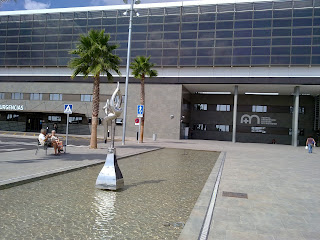My second experience of hospitals came not long after my first visit when I was once again at the Accident and Emergency department after my symptoms returned. Yet again, within 5 minutes of registering at the main reception desk, I was seen by the triage nurse, had my blood pressure and temperature taken and more blood taken for testing and was immediately seen by a doctor who once again put me on a drip for rehydration. The results of the tests came back shortly afterwards and I was told that unfortunately this time I was being admitted for further investigation and observation.
As I was now officially an “in-patient” and it was lunch time, I was given a meal and a drink much to my surprise. Shortly afterwards I was taken up to the ward which was actually a room with just 2 beds-it was much more like a private ward than a national health one-it even had an en-suite toilet complete with shower.
Mid afternoon I was given a snack and later that evening I was given dinner. At about 11pm I was offered a drink of either fruit juice or milk. (In total, 4 meals are provided during the day-breakfast, lunch, mid afternoon snack and evening dinner-and a night time drink is also provided)
The next day I had some more tests done and early afternoon I was moved to a ward on my own-officially I was put into isolation as I’d got a bacterial infection which was contagious (caused by antibiotics that I had been taking previously). All visitors had to put on a gown, face mask and gloves before entering my room and then had to remove them and leave them in the doorway when leaving to prevent any infection leaving the room.
After having more tests on the 4th day, I was finally told I was clear of the infection and would be allowed to go home. The doctor gave me a piece of paper with all the information about my stay, tests, etc and was told I had to take this to my own doctor for her to update my records.
There were several differences between British and Spanish hospitals that I noticed during my stay. One of the major and most surprising differences is that you are allowed to use your mobile phone virtually anywhere in the hospital and you do not need to switch it off when entering the hospital.
Another difference I came across was the fact that you can have visitors any time, day or night and there are no official “visiting hours”. The hospital also expects your family or friends to stay and assist you if you are not mobile e.g if you need a bedpan, they are expected to get it for you and empty it and they are also expected to help you shower and with general matters of hygiene. In your room they even provide a reclining chair for your visitor to sleep on when they stay during the night.
At mealtimes an announcement is made over a loudspeaker through an intercom to let you know that the meal will be arriving shortly so that you get your table ready. The family or friend helping you is expected to do this for you.
Another difference I came across was with regards to medication. An hour or so before your meal, a nurse comes in with your medication and leaves it with you and tells you take it with your meal-they don’t come back to see if you take the medication, they just trust you to take it at the right time.
The nurses do not normally come in on a regular basis to check on the patient-they normally only come in when they take your blood pressure or temperature or blood sugar levels or when they have to carry out any other tests or take blood. You are given a keypad which has a button to press if you want a nurse and when you press the button, it goes through to the nurses’ station and the nurse talks to you via the intercom to find out what you need. They will then come and see you if you need them.
The hospital was very clean, bright and very well maintained and all in all, the hospital treatment and service is of an exceptionally high standard.



